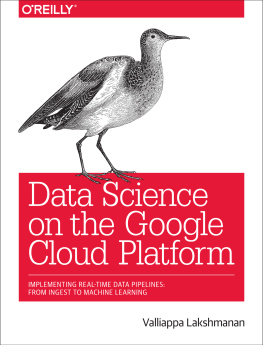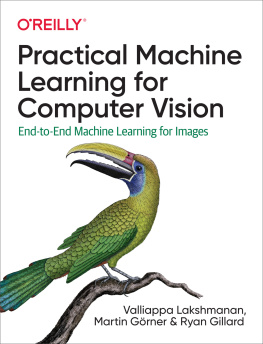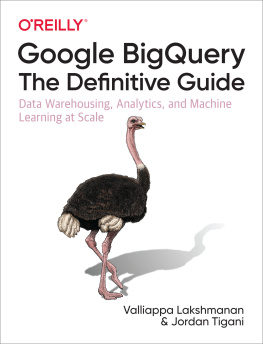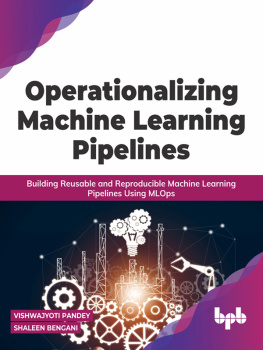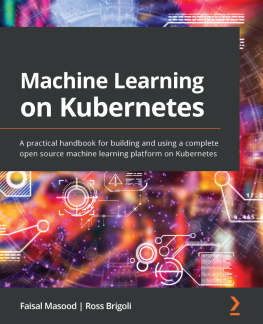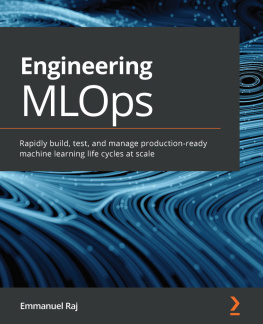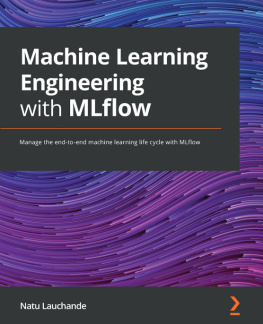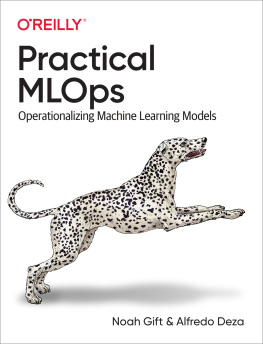Valliappa Lakshmanan - Machine Learning Design Patterns Solutions to Common Challenges in Data Preparation, Model Building, and MLOps
Here you can read online Valliappa Lakshmanan - Machine Learning Design Patterns Solutions to Common Challenges in Data Preparation, Model Building, and MLOps full text of the book (entire story) in english for free. Download pdf and epub, get meaning, cover and reviews about this ebook. year: 0, publisher: Valliappa Lakshmanan & Sara Robinson & Michael Munn, genre: Children. Description of the work, (preface) as well as reviews are available. Best literature library LitArk.com created for fans of good reading and offers a wide selection of genres:
Romance novel
Science fiction
Adventure
Detective
Science
History
Home and family
Prose
Art
Politics
Computer
Non-fiction
Religion
Business
Children
Humor
Choose a favorite category and find really read worthwhile books. Enjoy immersion in the world of imagination, feel the emotions of the characters or learn something new for yourself, make an fascinating discovery.
- Book:Machine Learning Design Patterns Solutions to Common Challenges in Data Preparation, Model Building, and MLOps
- Author:
- Publisher:Valliappa Lakshmanan & Sara Robinson & Michael Munn
- Genre:
- Year:0
- Rating:4 / 5
- Favourites:Add to favourites
- Your mark:
- 80
- 1
- 2
- 3
- 4
- 5
Machine Learning Design Patterns Solutions to Common Challenges in Data Preparation, Model Building, and MLOps: summary, description and annotation
We offer to read an annotation, description, summary or preface (depends on what the author of the book "Machine Learning Design Patterns Solutions to Common Challenges in Data Preparation, Model Building, and MLOps" wrote himself). If you haven't found the necessary information about the book — write in the comments, we will try to find it.
Machine Learning Design Patterns Solutions to Common Challenges in Data Preparation, Model Building, and MLOps — read online for free the complete book (whole text) full work
Below is the text of the book, divided by pages. System saving the place of the last page read, allows you to conveniently read the book "Machine Learning Design Patterns Solutions to Common Challenges in Data Preparation, Model Building, and MLOps" online for free, without having to search again every time where you left off. Put a bookmark, and you can go to the page where you finished reading at any time.
Font size:
Interval:
Bookmark:

by Valliappa Lakshmanan , Sara Robinson , and Michael Munn
Copyright 2021 Valliappa Lakshmanan, Sara Robinson, and Michael Munn. All rights reserved.
Printed in the United States of America.
Published by OReilly Media, Inc., 1005 Gravenstein Highway North, Sebastopol, CA 95472.
OReilly books may be purchased for educational, business, or sales promotional use. Online editions are also available for most titles (http://oreilly.com). For more information, contact our corporate/institutional sales department: 800-998-9938 or corporate@oreilly.com .
Acquisitions Editor: Rebecca Novack | Indexer: nSight, Inc. |
Developmental Editor: Corbin Collins | Interior Designer: David Futato |
Production Editor: Beth Kelly | Cover Designer: Karen Montgomery |
Copyeditor: Charles Roumeliotis | Illustrator: Kate Dullea |
Proofreader: Holly Bauer Forsyth |
- October 2020: First Edition
- 2020-10-15: First Release
See http://oreilly.com/catalog/errata.csp?isbn=9781098115784 for release details.
The OReilly logo is a registered trademark of OReilly Media, Inc. Machine Learning Design Patterns, the cover image, and related trade dress are trademarks of OReilly Media, Inc.
The views expressed in this work are those of the authors, and do not represent the publishers views. While the publisher and the authors have used good faith efforts to ensure that the information and instructions contained in this work are accurate, the publisher and the authors disclaim all responsibility for errors or omissions, including without limitation responsibility for damages resulting from the use of or reliance on this work. Use of the information and instructions contained in this work is at your own risk. If any code samples or other technology this work contains or describes is subject to open source licenses or the intellectual property rights of others, it is your responsibility to ensure that your use thereof complies with such licenses and/or rights.
978-1-098-11578-4
[LSI]
Introductory machine learning books usually focus on the what and how of machine learning (ML). They then explain the mathematical aspects of new methods from AI research labs and teach how to use AI frameworks to implement these methods. This book, on the other hand, brings together hard-earned experience around the why that underlies the tips and tricks that experienced ML practitioners employ when applying machine learning to real-world problems.
We assume that you have prior knowledge of machine learning and data processing. This is not a fundamental textbook on machine learning. Instead, this book is for you if you are a data scientist, data engineer, or ML engineer who is looking for a second book on practical machine learning. If you already know the basics, this book will introduce you to a catalog of ideas, some of which you (an ML practitioner) may recognize, and give those ideas a name so that you can confidently reach for them.
If you are a computer science student headed for a job in industry, this book will round out your knowledge and prepare you for the professional world. It will help you learn how to build high-quality ML systems.
This is a book that is primarily for ML engineers in the enterprise, not ML scientists in academia or industry research labs.
We purposefully do not discuss areas of active researchyou will find very little here, for example, on machine learning model architecture (bidirectional encoders, or the attention mechanism, or short-circuit layers, for example) because we assume that you will be using a pre-built model architecture (such as ResNet-50 or GRUCell), not writing your own image classification or recurrent neural network.
Here are some concrete examples of areas that we intentionally stay away from because we believe that these topics are more appropriate for college courses and ML researchers:
ML algorithmsWe do not cover the differences between random forests and neural networks, for example. This is covered in introductory machine learning textbooks.Building blocksWe do not cover different types of gradient descent optimizers or activation functions. We recommend using Adam and ReLUin our experience, the potential for improvements in performance by making different choices in these sorts of things tends to be minor.ML model architecturesIf you are doing image classification, we recommend that you use an off-the-shelf model like ResNet or whatever the latest hotness is at the time you are reading this. Leave the design of new image classification or text classification models to researchers who specialize in this problem.Model layersYou wont find convolutional neural networks or recurrent neural networks in this book. They are doubly disqualifiedfirst, for being a building block and second, for being something you can use off-the-shelf.Custom training loopsJust callingmodel.fit() in Keras will fit the needs of practitioners. In this book, we have tried to include only common patterns of the kind that machine learning engineers in enterprises will employ in their day-to-day work.
As an analogy, consider data structures. While a college course on data structures will delve into the implementations of different data structures, and a researcher on data structures will have to learn how to formally represent their mathematical properties, the practitioner can be more pragmatic. An enterprise software developer simply needs to know how to work effectively with arrays, linked lists, maps, sets, and trees. It is for a pragmatic practitioner in machine learning that this book is written.
We provide code for machine learning (sometimes in Keras/TensorFlow, and other times in scikit-learn or BigQuery ML) and data processing (in SQL) as a way to show how the techniques we are discussing are implemented in practice. All the code that is referenced in the book is part of our GitHub repository, where you will find fully working ML models. We strongly encourage you to try out those code samples.
The code is secondary in importance to the concepts and techniques being covered. Our aim has been that the topic and principles should remain relevant regardless of changes to TensorFlow or Keras, and we can easily imagine updating the GitHub repository to include other ML frameworks, for example, while keeping the book text unchanged. Therefore, the book should be equally informative if your primary ML framework is PyTorch or even a non-Python framework like H20.ai or R. Indeed, we welcome your contributions to the GitHub repository of implementations of one or more of these patterns in your favorite ML framework.
If you have a technical question or a problem using the code examples, please send email to .
This book is here to help you get your job done. In general, if example code is offered with this book, you may use it in your programs and documentation. You do not need to contact us for permission unless youre reproducing a significant portion of the code. For example, writing a program that uses several chunks of code from this book does not require permission. Selling or distributing examples from OReilly books does require permission. Answering a question by citing this book and quoting example code does not require permission. Incorporating a significant amount of example code from this book into your products documentation does require permission.
Font size:
Interval:
Bookmark:
Similar books «Machine Learning Design Patterns Solutions to Common Challenges in Data Preparation, Model Building, and MLOps»
Look at similar books to Machine Learning Design Patterns Solutions to Common Challenges in Data Preparation, Model Building, and MLOps. We have selected literature similar in name and meaning in the hope of providing readers with more options to find new, interesting, not yet read works.
Discussion, reviews of the book Machine Learning Design Patterns Solutions to Common Challenges in Data Preparation, Model Building, and MLOps and just readers' own opinions. Leave your comments, write what you think about the work, its meaning or the main characters. Specify what exactly you liked and what you didn't like, and why you think so.


